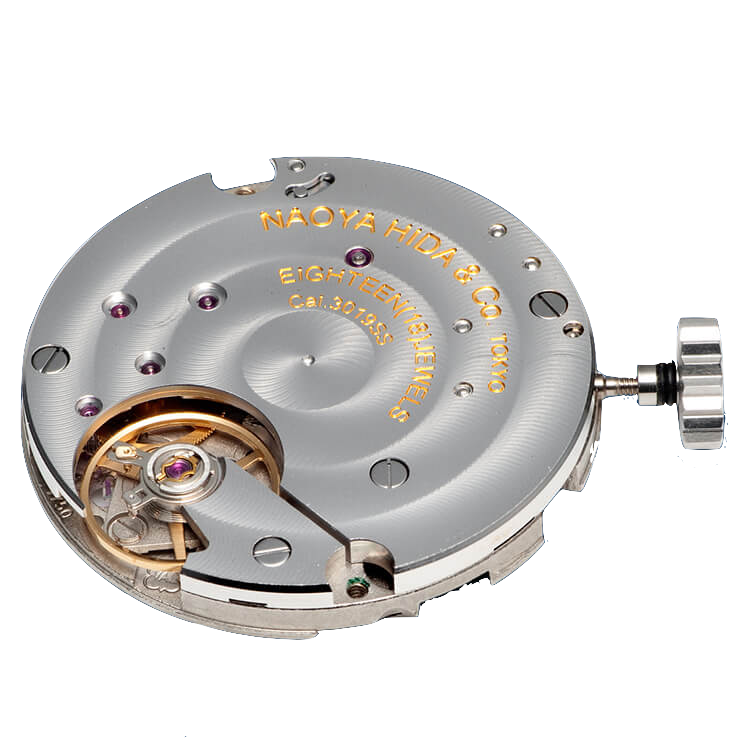Cal. 30 is a family of hand-winding movements from Naoya Hida & Co. based on the ETA 7750 ebauche. The original Cal. 3019SS (with small seconds at 9:00) debuted in 2019 in the NH Type 1, followed by Cal. 3020CS in 2020 in the NH Type 2, and Cal. 3021LU in 2021 in the NH Type 3.
Hida’s movements use the Cal. 7750 main plate, barrel, wheel train, and escapement with a custom 3/4 plate and balance cock. The automatic winding system is removed, replaced by a custom click for hand winding, and the chronograph and date complications are removed. Cal. 3020CS uses a wheel on the back for central seconds while Cal. 3021LU uses the moon phase complication from ETA’s Cal. 7751.
The NH Cal. 30 Family
All three Hida movements to date have a similar appearance, and all are based on the 7750 ebauche, wheel train, barrel, balance, and escapement. The small seconds and moon phase movements likely share the same balance bridge and plate, and both feature 18 jewels.
The central seconds hand on Cal. 3020CS is driven using a rear-mounted wheel, requiring a secondary plate at the center. It also features four extra jewels, for a total of 22.
Cal. 3021LU, used in the Type 3, uses the moon phase mechanism from ETA’s Cal. 7751 but omits a seconds display entirely. Like Cal. 7751, the moon phase indicator is adjusted with the crown in position 2.
A Hand-Winding 7750
See also my articles, “The Neo-Classical Watches of Naoya Hida” and “The Surprising Calibres of Naoya Hida”
Edmond Capt designed the classic ETA 7750 for Valjoux in 1974, and his integrated automatic chronograph movement was one of the most significant designs of the 20th century. Although it borrows some technology from the previous Valjoux 7740, Valjoux 7730, and Venus 188 Family, the 7750 was a thorough redesign and can rightly be called a completely new movement. It combined durable and efficient automatic winding, “high beat” 28,800 A/h operation, inexpensive cam-based construction, and flexible support for many complications and became one of the leading movements in the 1970s. When mechanical watchmaking returned in the 1980s, the 7750 once again lead the way, and it continues in production to this day at ETA and Sellita.
The 7750 ebauche is a popular base for complications and derived movements, including ETA’s own Valgranges family, and it is often heavily modified. There are a number of column wheel chronograph movements based on it, and it is also popular among makers of fine independent watches. For example, the Habring² Felix Cal. A11 uses this base, and is a hand-winding time-only movement with a custom balance bridge and plate and in-house escapement and hairspring.
Naoya Hida chose the 7750 ebauche for a similar hand-winding movement. It obviously omits the automatic winding and chronograph components, but there are many other changes. The NH series 30 is fitted with a Glashütte-style 3/4 plate, which covers the wheel train and winding components, exposing only the balance wheel and Hida-specific balance bridge. Hida movements also use a proprietary click mechanism to improve the feel when winding by hand. Hida’s movements use ETACHRON but lack the historic Valjoux regulator or any indexing system.
The wheel train, assortment (balance and escapement), and mainspring are held over from the 7750, as are the springs and shock absorbers. Thus, the movement operates at 4 Hz (28,800 A/h) and has a power reserve of around 45 hours. Without the chronograph components, Hida’s movements have 18 or 22 jewels.
The movement plate is decorated with a concentric pattern of overlapping spirals. It is likely that the plate and balance bridge are produced by an outside company, but they are nicely decorated, with engraved gold-filled lettering. The main plate still retains the ETA cloverleaf and “775x” stamps and does not appear to be re-worked or finished. The main plate is modified for Cal. 3020CS with a secondary plate to cover the central seconds wheels.
